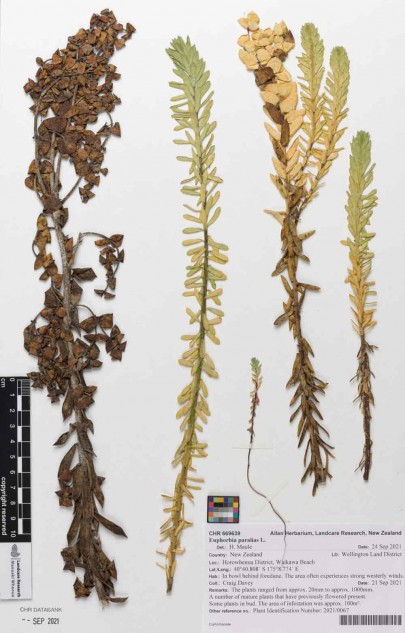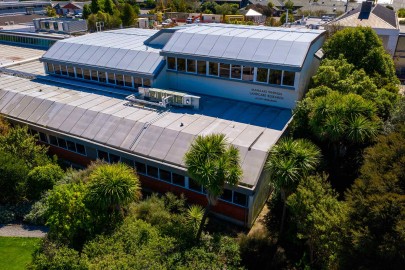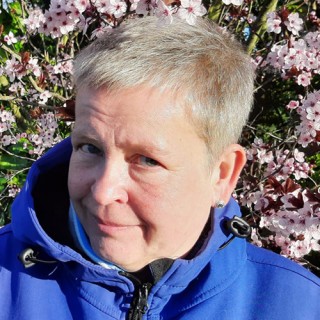Keeping Track of the Adventive Plant Species in New Zealand

Euphorbia paralias herbarium specimen
The term ‘adventive’ is derived from the Latin advena, meaning a stranger or immigrant. It can therefore be applied to all non-indigenous/exotic wild plants growing in NZ, since all have had an ‘advent’. Some of these introduced plant species become fully naturalised, while others never establish, being collected once and never seen again. Some remain at the site where they were first introduced, likely finding the conditions marginal and lacking the means of dispersal to transfer them to areas with more favourable conditions for growth. If an adventive species forms self-sustaining populations in its new geographical area it is termed ‘naturalised’. Generally, naturalised plants are viewed as weeds.
The adventive flora of NZ was either accidentally introduced (e.g. in stock feed), or deliberately introduced for various purposes (e.g. ornamental or dune stabilisation) and later escaped cultivation. Many early accidental introductions were of temperate weeds that became widespread, accompanying settlers or arriving as stowaways with crop seed, cargo, and ballast. The first plants to become naturalised in NZ were those brought here by Polynesian settlers, but following European settlement there was a rapid increase in the number of naturalised species.
The adventive flora of NZ primarily occupies lowlands, wastelands, roadsides, farms, gardens, and other disturbed and modified places where native plants have been displaced because of human activities. In part, the success of introduced plant species in NZ can be attributed to the paucity of native species, particularly annuals, that rapidly occupy continuously disturbed habitats. NZ’s equable climate and wide range of latitudes have allowed a great diversity of species to become established. Over the last 250 years, plants from all continents except Antarctica have found their way to NZ and have become naturalised. In many cases, weedy species have not come directly to NZ from their area of endemism, but came indirectly via other countries (notably Britain and Australia) where they are also naturalised.
With their observations of the diversity and rapid increase in the number of naturalised plant species in NZ, early botanists feared they would threaten the survival of native flora. “Records of the introduction and naturalisation of seed plant species have come from many sources, varying in accuracy,” explained Ines Schӧnberger, Manager of the Allan Herbarium. “A foundation was laid in the writings of botanists Thomas Kirk (1871) and Thomas Cheeseman (1883), and with their voucher specimens in NZ herbaria. These specimens, and those of later collectors, specify collection dates, elucidating when certain species were known to be in NZ, and serving as voucher specimens for accuracy of identification,” she added. Much later, the Flora of New Zealand Vol. IV (1995) by Colin Webb and colleagues was the first comprehensive treatment of naturalised plants in NZ since HH Allan’s Handbook of the Naturalised Flora of New Zealand of 1940. Webb’s book covered 1470 naturalised species, summarising the findings of publications and checklists by several authors from 1943 to 1988.
The invasion of exotic plants did not stop there. It has been continuing at a rapid pace, with new records of naturalisations published in various checklists from 1988 onwards. For example, another 398 species were added to the list between 1994 and 2006, in five checklists produced by Peter Heenan and colleagues. In 2021 another 42 plant species were added to the list of naturalised plants, and so far this year another 15 species have been recorded as naturalised in NZ.
The adventive flora will, of course, continue to change. Some species have disappeared from the flora as a result of changing agricultural practices, and new species will become naturalised. The rate of new naturalisations shows no sign of abating, so it is expected that the list will continue to grow accordingly. Approximately 30,000 exotic plants (including all cultivated food plants and ornamentals) are already in NZ, and new, non-native species will continually enter the country and become established, although some may not persist or may remain innocuous.

The Allan Herbarium
To anticipate population explosions of these often potentially harmful weeds, it is important to accurately track their presence and spread. Much attention has been paid to the negative effects of adventive species on native ecosystems, but studies seeking to find out when and where these species started to become naturalised are scarce. Similarly, accurate distribution data of adventive plant species are not easy to find. The Allan Herbarium (and other herbaria) address these issues by providing access to primary specimen data. Herbarium specimens are among the most accessible and verifiable sources of data on distribution and habitat. A herbarium specimen is a voucher documenting a species growing at a given site at a certain time.
Herbarium data, increasingly available in digital format, allows us to attempt to reconstruct invasion histories, and to determine periods of species influx, invasion extents, and invasion niche shifts. The Systematics Collections Data website provides access to specimens from the Allan Herbarium (https://scd.landcareresearch.co.nz). This website is intended primarily for researchers and workers who require access to ‘unsanitised’ collection data. However, high-resolution images of some specimens are available to enable everybody to observe information first hand without having to interpret herbarium label information. By providing images of the actual specimens, identifications and confirmations are made possible.
Tracking the introduction and spread of adventive species increasingly plays a vital role in both basic research and applied fields. A strong collection of herbarium specimens is the critical resource necessary to examine such floristic changes and to identify new potential weeds. Herbarium specimens can help determine how fast weeds spread, provide evidence that a lag phase in the spread of weeds exists, and help estimate the length of such lag phases.
So where do our herbarium specimens come from? Specimens and associated collection data are submitted by plant taxonomists, ecologists, Department of Conservation staff, horticulturalists, farmers, members of the public, and biosecurity officers. “In recent years biosecurity officers have been contributing significantly to the Allan Herbarium by using the Plant Identification Service offered to members of the National Biocontrol Collective. Fresh plant specimens are sent to the herbarium for identification, confirmation, and accessioning,” said Ines.
Biosecurity officers check areas of land for harmful plants and arrange for, or help with, pest destruction and control. On average, the Allan Herbarium receives 400–600 plant samples per year from the biosecurity officers for identification. “Recently, we have received additional specimens of Chilean needle grass (Nassella neesiana) as evidence of its range expansion; a “wild” pineapple plant (Ananas comosus) was collected in Taranaki; biosecurity officers found a specimen of cascara (Frangula purshiana) growing wild in a pine forest in Hiwipango, Nelson – a species that was last collected in this area in 1981; common reed (Phragmites karka) is taking off in the Wellington region; the first naturalised water figwort (Scrophularia auriculata) population has been found in Southland; and biosecurity officers have been collecting and sending in sea spurge (Euphorbia paralias) specimens, highlighting the threat of this species to New Zealand’s coastal ecosystems,” said Ines. “These are only very few examples, but they demonstrate how important it is to have ears, eyes, and hands on the ground to assist us with keeping track of the adventive seed plant flora in New Zealand,” she concluded.

